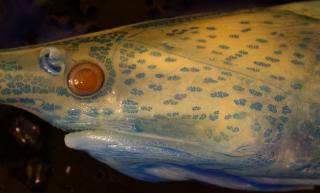A team of researchers at the University of Missouri’s Center for Neurodynamics, located at St Louis had determined in 1997 that the paddlefish, one of North America’s largest freshwater fish, has electroreceptors covering its extended snout to help the paddlefish detect its prey by detecting voltage gradients emitted by the zooplankton.
 Electroreceptors on the head of a paddlefish
Electroreceptors on the head of a paddlefish
Latest research by the scientists has led them to uncover that the electroreceptors comprise oscillators capable of rhythmic burst of electrosensory neurons, allowing the electroreceptors to generate a dynamic code whereby an effective response to electrical signals that the zooplankton naturally emitted was provided.
A paper titledSensory Coding in Oscillatory Electroreceptors of Paddlefish has been published in the American Institute of Physics’ online journal Chaos.
The researchers tested the response of the electroreceptors present in the paddlefish, to various stimuli by recording the signals generated by electrosensory neurons of certain live fish while creating weak field of electricity in the water using computer-generated stimuli obtained earlier from swimming zooplankton. The researchers continued to investigate the power in various frequency ranges for input signals and their corresponding electroreceptor responses. After comparison, the results indicated that not only did the sensors in the paddlefish encode the zooplankton signals impeccably but also deduced that when the input signal’s strength was raised, the sensory neurons of the fish changed from a constant beat to noisy intermittent bursts.
The bursting form of the neurons synchronized across various electroreceptor groups. This research helps the researchers find an explanation to how the information of the prey’s proximity is signaled to the brain of the fish.